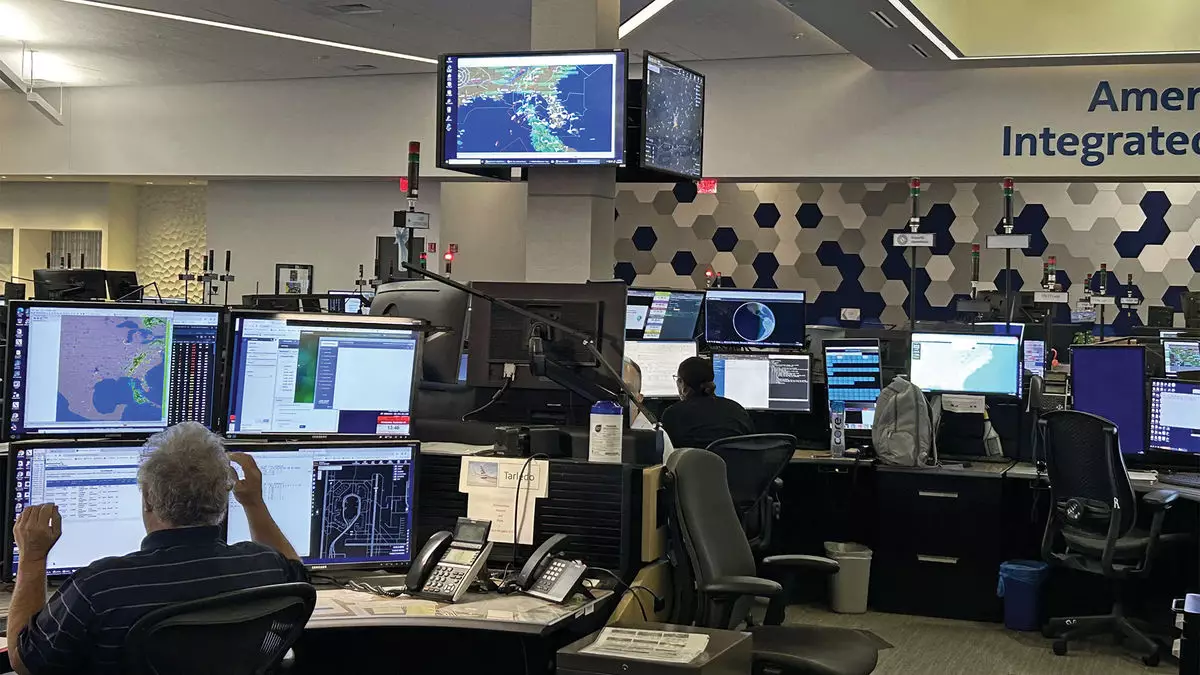On the afternoon of September 25, Hurricane Helene churned threateningly in the Gulf of Mexico, poised to impact Florida’s vast air traffic. Despite the looming disaster, the American Airlines Integrated Operations Center (IOC) in Dallas maintained an aura of composure. System Customer Service Manager Mark Groat surveyed the scene, observing that the operational center, staffed by approximately 375 employees, was far from chaotic. Instead, it was a testament to the airline’s meticulous preparation and its capability to handle challenges even when the stakes were high. With storm paths displayed prominently on sleek, multi-monitor workstations, one couldn’t help but admire the advanced systems at play.
While major flight cancellations were inevitable, with predictions showing over 750 impending cancellations in the following days, the IOC’s efforts focused on minimizing disruptions as much as possible. The early designation of only 44 canceled flights, primarily in Tampa where the airport’s closure had already been announced, indicated a strategically proactive approach. This initial cancelation figure highlighted how American Airlines was not merely waiting for storms to dictate its next moves but was instead actively reshaping its operations in anticipation of the conditions to come.
As Hurricane Helene’s trajectory became clearer, a vital aspect of American Airlines’ strategy emerged: real-time communication. On the morning of the hurricane’s assault, the IOC was in constant dialogue with local airport general managers across Florida. This collaboration was crucial for understanding operational limitations and thresholds needed for effective storm response. The airline had already issued flight waivers to provide flexibility for traveler schedules, demonstrating a commitment to customer service even amid chaos.
Concurrent with concerns about Florida’s airports, American Airlines shifted its focus toward potential disruptions at its inland hub in Charlotte. The severity of the storm meant that the airline had to think several steps ahead, adjusting its strategies as new data came in. Acknowledging the reality that hurricanes can and do weaken in intensity, the IOC was quick to adapt and informed its operational plans accordingly when Cancun saw a last-minute improvement in weather conditions, allowing for a mere postponement rather than flight cancellations.
To effectively navigate the unfolding situation, American Airlines utilized a tool known as the Hub Efficiency Analytics Tool (HEAT). This proprietary program allows the airline to scrutinize an array of factors, including real-time weather data, air traffic constraints, and gate availability. Such insights equip operations teams to make informed decisions about flight schedules, ultimately striving to optimize passenger outcomes while mitigating operational risks.
As Hurricane Helene bore down on Florida, American’s flight dispatchers maintained close communication with the Federal Aviation Administration (FAA) to ensure alignment with air traffic control protocols. Given that disruptions were expected, particularly in the bustling hub of Miami, anticipatory measures included delaying some flights to alleviate congestion. This fluidity in scheduling illustrates a sophisticated operational mindset, one where American Airlines adopts a hands-on approach rather than simply reacting to challenges as they arise.
American Airlines’ response plan encompassed various strategic layers, including financial perspectives. Amid turbulence caused by the hurricane, the airline capitalized on the situation by leveraging the urgent need for travel. Additional flights out of Tampa were not only an emergency measure for evacuating passengers but also functioned as a revenue-generating initiative. Bringing planes out of potentially hazardous conditions while still providing services allowed the airline to balance its responsibilities to customers with its fiscal obligations.
By the afternoon of September 25, one of the newly introduced flights from Tampa to Dallas had already garnered interest, quickly booking 45 passengers within just an hour. This demonstrated not only the demand but also American Airlines’ adeptness in navigating the chaotic landscape of air travel during emergencies.
As Hurricane Helene unfolded, American Airlines’ decision-making process resembled a complex puzzle, with various moving parts intricately linked. The lead dispatcher, who has the final say on flight cancellations, weighs inputs from multiple divisions, ensuring that all angles are considered. Factors such as aircraft maintenance, crew availability, and the implications for customers all play crucial roles in ensuring that the airline’s operations continue as smoothly as possible.
For instance, keeping flights operational for passengers transferring to international flights shows a customer-centric focus, prioritizing those whose travel plans might be significantly disrupted. Reflecting on this process, Groat noted that given the high stakes, the aim remained to foster the least amount of disruption possible—a testament to the airline’s commitment to its travelers.
American Airlines’ response to Hurricane Helene is emblematic of the broader art of crisis management. By combining technological resources, real-time data, well-honed communication channels, and a proactive culture, the airline was not just weathering the storm but actively managing the chaos. This level of preparedness does not merely minimize operational fallout; it reaffirms a crucial tenet of the airline industry: that effective crisis management can lead to enhanced customer loyalty even in the worst of conditions. Through strategic planning and execution, American Airlines exemplified how an airline can rise above the challenges posed by nature, ensuring that its passengers remain front and center.

